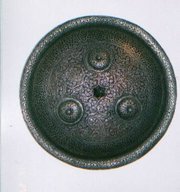Shield
|
|
- This article is about the defensive device. For other meanings of the word see shield (disambiguation)
A shield is a protective device, meant to intercept attacks. The term often refers to a device that is held in the hand, as opposed to armour or a bullet proof vest.
The oldest form of shield was a protection used to block attacks by hand weapons and missiles. Shields have varied greatly in construction over time and place. Sometimes shields were made of metal, but wood or animal hide construction was very much more common, wicker and even turtle shells have been used. Many surviving examples of metal shields are generally felt to be ceremonial rather than practical, for example the Battersea shield.
Size and weight varied greatly, lightly armoured warriors relying on speed and surprise would generally carry light shields that were either small or thin. Heavy troops might be equipped with large heavy shields that could protect most of the body. In some cases, a shield would be free standing. Shields of this type (pavise) were used by medieval crossbowmen who needed protection while reloading. These shields were so heavy that the crossbowman required an assistant to move it.
Ancient Greek hoplites used a round, bowl-shaped wooden shield called a hoplon.
The heavily armoured Roman legionaries carried large rectangular shields (scuta) that could provide far more protection, but made swift movement more difficult. Famously the Romans used their shields to create a tortoise-like formation called a testudo in which the entire group of fighters would be enclosed in an armoured box.
Many ancient shield designs featured incuts of one sort of another. This was done to accommodate the shaft of a spear thus facilitating tactics requiring the soldiers to stand close together forming a wall of shields.
In the European early Middle Ages so-called kite shaped shields, these were rounded at the top and tapered at the bottom. They were easily used on horseback and allowed easier leg movement when dismounted. As personal body armour improved, knight's shields became smaller, leading to the familiar "heater" style. Both kite and heater style shields were made of several layers of laminated wood, with a gentle curve in cross section. The heater style inspired the shape of the heraldic shield that is still used today. Eventually, specialised shapes were developed such as the bouche — which had a lance rest cut into the upper corner of the lance side, to help guide it in combat or tournament.
In time, some armoured foot knights gave up shields entirely in favour of mobility and two-handed weapons. Other knights and common soldiers adopted the buckler. The buckler is a small round shield, typically between 8 and 16 inches in diameter. The buckler was one of very few types of shield that was commonly made of metal. Small and light, the buckler was easily carried by being hung from a belt; it gave little protection from missiles and was reserved for hand-to-hand combat. The buckler continued in use well into the 16th century.
Shields continued in use even after gunpowder powered weapons made them nearly obsolete in the battlefield. In the 18th century, the Scottish clans used a small, heavy, round shield called a targe that was partialy effective against the firearms of the time.
In the 19th century, non-industrial cultures with little access to guns were still using shields. Zulu warriors carried large lightweight shields made from a single ox hide supported by a wooden spine. This was used in combination with a short spear (assegai) and/or club.
Shields for protection from armed attack are still used by many police forces around the world.
Many non-martial devices also employ shields. Space craft have heat shields to ensure a safe re-entry. Electronics uses shielding to reduce electrical noise and crosstalk between signals. People and systems that must work in the presence of ionizing radiation are protected with shielding.
Science fiction writers have imagined many futuristic shields, usually using force fields. These include personal shields, as in the Dune series, or larger ones for spacecraft as in Star Trek. See shield (science fiction) for more.bg:Щит cs:Štít da:Skjold de:Schild (Waffe) et:Kilp es:Escudo fr:Bouclier (arme) he:מגן hu:Pajzs nl:Schild ja:盾 pl:Tarcza pt:Escudo ru:Щит sl:Ščit sv:Sköld

